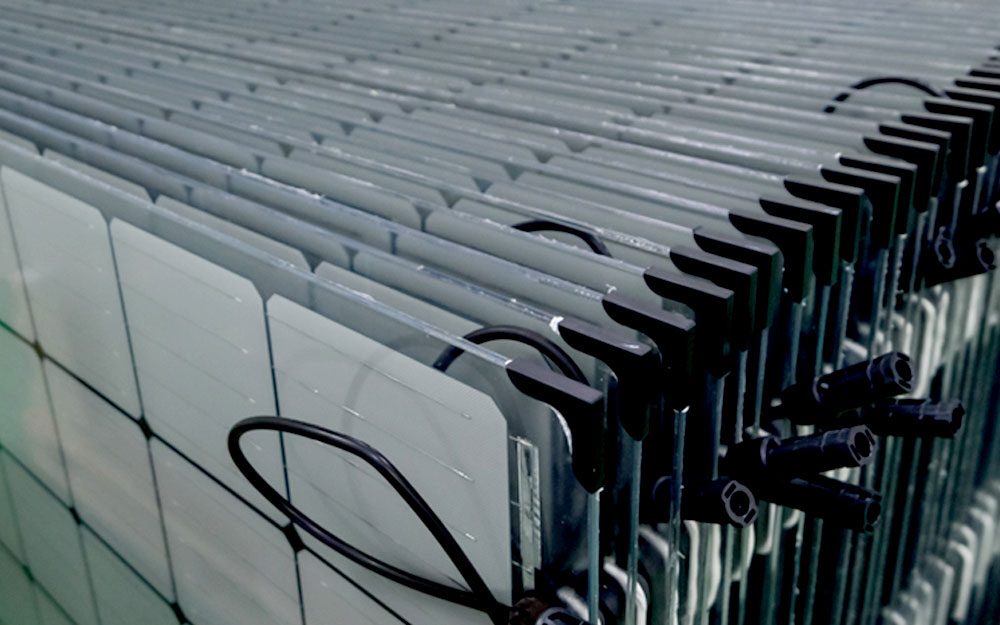Glass-glass module structures (Dual Glass or Double Glass) is a technology that uses a glass layer on the back of the modules instead of the traditional polymer backsheet. Originally double-glass solar panels were heavy and expensive, allowing the lighter polymer backing panels to gain most of the market share.
glass-glass is making a comeback, based on an increase in the market share of bifacial modules and an increase in the number of PV installations on a business scale and solar farms preferring more durable module designs such as glass-glass.
Double-glazed modules are characterized by increased reliability, especially for large-scale photovoltaic projects. They include better resistance to higher temperatures, humidity and UV conditions, and have better mechanical stability, reducing the risk of microcracks during installation and operation. Double Glass is especially important in photovoltaic facilities such as solar power plants and with the expected long service life of modules.
SunEvo-Solar-Double-Glass-Photovoltaic-Solar-Panels-Module-Structure
Why solar panels with glass-glassTechnology?
- BEST PERFORMANCE
Highest Efficiency And Power Of Solar Panels
- LONG WARRANTY
30 Years With Only 0,4% Annual Degradation
- INSPIRING TECHNOLOGY
N-Type Bifacial Cells Cover In Glass Glass Frame
Why is solar double glass more durable?
An important change that has been made in the case of Glass-Glass modules is the replacement of EVA with polyolefins as an encapsulating substance. This is due to the free radicals generated during the EVA cross-link lamination process. While traditional backsheets are somewhat permeable to free radicals, the double glass module is not. The same can be said for moisture that can seep in from the sides of the module and get trapped in the double-glazed structure. Therefore, the impermeability of these degrading agents is a major argument against glass-to-glass as it traps both free radicals and moisture inside the module, potentially shortening its field life. The issue of trapped moisture is actually the main argument against double glass modules. Polyolefins are used as encapsulating substances, which solves the problem of free radicals and the problem of moisture is solved by the execution, which is confirmed by e.g. PVEL tests.

Glass-Glass for the PV Farm?
Due to the increased reliability of the double glazing unit design, they are expected to degrade only 0.4% per year on average, as opposed to the traditional polymer back layer at 0.7% per year. Therefore. over 30 years of operation, it can be expected to continue to operate at 85% of the rated power (some modules already reach over 87% after 30 years).
The advantages of Double Glass Solar Modules?
- Rear Side Module Protection
The glass on the back avoids the risks associated with the back film as it is not exposed to moisture, alkalinity, acidity, salinity, ultraviolet radiation, or temperature. It is a PID-free product as it does not allow the effect of the back foil on inductive degeneration.
- Highest Fire Resistance
Most common configuration for Bifacial Solar Panels is double glass. And even when bifacial modules have not have Fire Class A, still is much more protect anti-fire than standard back sheet modules. Especially on residential roof solar installation bifacial glass glass technology is must be chosen.
- Glass Glass COVER
Due to the increased reliability of the double glazing module design, they are expected to degrade only 0.4% per year on average, as opposed to the traditional polymer back layer at 0.7% per year. Therefore. over 30 years of operation, it can be expected to continue to operate at 85% of rated power (some modules already reach over 87% after 30 years).
- Bifacial POWER
Due to the technical production and properties of N-type silicon cells, the bifaciality of HJT Solar Panels is the highest on market at 80-95%. PERC bifacial factor is on average level 70%. HJT cells are the best solution for bifacial solar modules. Generally bifacial panels enables 5%-30% energy gain on the back, depending on the factors such as ground reflection, region type etc.
- Lowest Degradation
Glass is a better heat sink, therefore the panel operates at a lower temperature, improving performance. Greater strength and durability. Since it is a more rigid product, it has a lower risk of silicon cell breakage during transportation and installation. This reduces the risk of hot spots. Glass glass modules degrade less over the years due to the strength of the glass.
- Strength And Durability
Glass-glass modules degrade less over the years due to the strength of the glass. The photovoltaic panel is more resistant to blown sand and corrosion in general. It better withstands gusts of wind and mechanical snow loads. Because it is a more durable product, it allows manufacturers such as AKCOME, Jinergy, or ZnShine to provide extended warranties and lower wear: – 12 years or even 15 years warranty.

